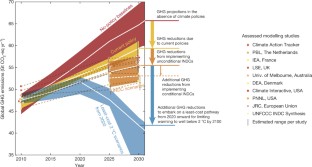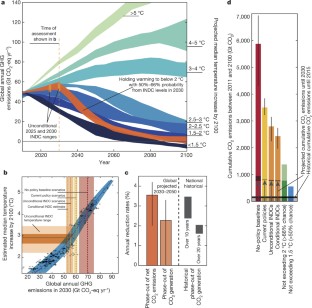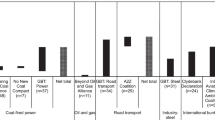Paris Agreement climate proposals need a boost to keep warming well below 2 °C
The Paris climate agreement aims at holding global warming to well below 2 degrees Celsius and to “pursue efforts” to limit it to 1.5 degrees Celsius. To accomplish this, countries have submitted Intended Nationally Determined Contributions (INDCs) outlining their post-2020 climate action. Here we assess the effect of current INDCs on reducing aggregate greenhouse gas emissions, its implications for achieving the temperature objective of the Paris climate agreement, and potential options for overachievement. The INDCs collectively lower greenhouse gas emissions compared to where current policies stand, but still imply a median warming of 2.6–3.1 degrees Celsius by 2100. More can be achieved, because the agreement stipulates that targets for reducing greenhouse gas emissions are strengthened over time, both in ambition and scope. Substantial enhancement or over-delivery on current INDCs by additional national, sub-national and non-state actions is required to maintain a reasonable chance of meeting the target of keeping warming well below 2 degrees Celsius.
This is a preview of subscription content, access via your institution
Access options
Subscribe to this journal
Receive 51 print issues and online access
196,21 € per year
only 3,85 € per issue
Buy this article
- Purchase on SpringerLink
- Instant access to full article PDF
Prices may be subject to local taxes which are calculated during checkout


Similar content being viewed by others

Supporting the Paris Agreement through international cooperation: potential contributions, institutional robustness, and progress of Glasgow climate initiatives
Article Open access 29 April 2024

Taking stock of national climate policies to evaluate implementation of the Paris Agreement
Article Open access 29 April 2020

Realization of Paris Agreement pledges may limit warming just below 2 °C
Article 13 April 2022
Change history
References
- UNFCCC. Adoption of the Paris Agreement. Report No. FCCC/CP/2015/L.9/Rev.1, http://unfccc.int/resource/docs/2015/cop21/eng/l09r01.pdf (UNFCCC, 2015)
- UNFCCC. INDCs as communicated by Parties. http://www4.unfccc.int/submissions/indc/Submission%20Pages/submissions.aspx (2015)
- UNFCCC. United Nations Framework Convention on Climate Change. Report No. FCCC/INFORMAL/84, https://unfccc.int/resource/docs/convkp/conveng.pdf (UNFCCC, 1992)
- Knutti, R., Rogelj, J., Sedlácˇek, J. & Fischer, E. M. A scientific critique of the two-degree climate change target. Nat. Geosci.9, 13–18 (2016) ArticleADSCASGoogle Scholar
- Randalls, S. History of the 2°C climate target. Wiley Interdiscip. Rev. Clim. Change1, 598–605 (2010).An introduction to the roots of the 2 °C climate target and its development over the past decadesArticleGoogle Scholar
- Collins, M. et al. in Climate Change 2013: The Physical Science Basis.Contribution of Working Group I to the Fifth Assessment Report of the Intergovernmental Panel on Climate Change (eds Stocker T. F. et al.) 1029–1136 (Cambridge Univ. Press, 2013)
- Matthews, H. D. & Caldeira, K. Stabilizing climate requires near-zero emissions. Geophys. Res. Lett.35, L04705 (2008) ArticleADSGoogle Scholar
- Knutti, R. & Rogelj, J. The legacy of our CO2 emissions: a clash of scientific facts, politics and ethics. Clim. Change133, 361–373 (2015) ArticleADSCASGoogle Scholar
- IPCC. Climate Change 2014: Synthesis Report. Contribution of Working Groups I, II and III to the Fifth Assessment Report of the Intergovernmental Panel on Climate Change (IPCC, 2014).The most recent intergovernmental report synthesizing our current understanding of the physical science and impacts of, and possible solutions to avoid, climate change.
- Meinshausen, M. et al. Greenhouse-gas emission targets for limiting global warming to 2 °C. Nature458, 1158–1162 (2009) ArticleADSCASGoogle Scholar
- Rogelj, J. et al. Differences between carbon budget estimates unravelled. Nat. Clim. Change6, 245–252 (2016) ArticleADSGoogle Scholar
- Friedlingstein, P. et al. Persistent growth of CO2 emissions and implications for reaching climate targets. Nat. Geosci.7, 709–715 (2014) ArticleADSCASGoogle Scholar
- Rogelj, J., McCollum, D. L., Reisinger, A., Meinshausen, M. & Riahi, K. Probabilistic cost estimates for climate change mitigation. Nature493, 79–83 (2013) ArticleADSGoogle Scholar
- Luderer, G. et al. Economic mitigation challenges: how further delay closes the door for achieving climate targets. Environ. Res. Lett.8, 034033 (2013) ArticleADSGoogle Scholar
- Rogelj, J. et al. Energy system transformations for limiting end-of-century warming to below 1.5 °C. Nat. Clim. Change5, 519–527 (2015) ArticleADSGoogle Scholar
- Clarke, L. et al. in Climate Change 2014: Mitigation of Climate Change. Contribution of Working Group III to the Fifth Assessment Report of the Intergovernmental Panel on Climate Change (eds Edenhofer O. et al.) 413–510 (Cambridge Univ. Press, 2014)
- Rogelj, J. et al. Zero emission targets as long-term global goals for climate protection. Environ. Res. Lett.10, 105007 (2015). Study providing insights about the consistency between Article 2 and Article 4 of the UNFCCC Paris Agreement.ArticleADSGoogle Scholar
- UNEP. The Emissions Gap Report 2015http://uneplive.unep.org/media/docs/theme/13/EGR_2015_301115_lores.pdf (UNEP, 2015). An annual assessment tracking climate policy action over the past six years, which provided the basis for the analysis presented in this Perspective
- Climate Analytics, Ecofys, NewClimate Institute & PIK. Climate pledges will bring 2.7°C of warming, potential for more action. Climate Action Trackerhttp://climateactiontracker.org/news/253/Climate-pledges-will-bring-2.7C-of-warming-potential-for-more-action.html (2015)
- Admiraal, A. et al. Assessing Intended Nationally Determined Contributions to the Paris Climate Agreement – What are the Projected Global and National Emission Levels for 2025–2030? Report No. PBL 1879, http://www.pbl.nl/en/publications/assessing-intended-nationally-determined-contributions-to-the-paris-climate-agreement (PBL Netherlands Environmental Assessment Agency, 2015)
- IEA. World Energy Outlook 2015. International Energy Agencyhttp://www.worldenergyoutlook.org/resources/energyandclimatechange/ (2015)
- Boyd, R., Cranston Turner, J. & Ward, B. Intended Nationally Determined Contributions: What are the Implications for Greenhouse Gas Emissions in 2030?http://www.lse.ac.uk/GranthamInstitute/wp-content/uploads/2015/10/Boyd_Turner_and_Ward_policy_paper_October_2015.pdf (Centre for Climate Change Economics and Policy, and Grantham Research Institute on Climate Change and the Environment, 2015)
- Meinshausen, M. INDC Factsheets. Australian-German Climate and Energy Collegehttp://climate-energy-college.net/indc-factsheets (2015)
- DEA. Analyzing the 2030 emissions gap. Danish Energy Agencyhttp://www.ens.dk/gap (2015)
- Climate Interactive. Climate Scoreboard. Climate Interactivehttps://www.climateinteractive.org/programs/scoreboard/ (2015)
- Fawcett, A. A. et al. Can Paris pledges avert severe climate change? Science350, 1168–1169 (2015) ArticleADSCASGoogle Scholar
- UNFCCC. Synthesis Report on the Aggregate Effect of the Intended Nationally Determined Contributions. Report No. FCCC/CP/2015/7, http://unfccc.int/resource/docs/2015/cop21/eng/07.pdf (UNFCCC, 2015)
- Kitous A. & Keramidas K. Analysis of Scenarios Integrating the INDCshttps://ec.europa.eu/jrc/sites/default/files/JRC97845.pdf (Joint Research Centre, 2015)
- den Elzen, M. et al. Enhancing Mitigation Ambitions in the Major Emitting Countries: Analysis of Current and Potential Climate Policies. Report No. PBL 1631, http://www.pbl.nl/en/publications/enhancing-mitigation-ambitions-in-the-major-emitting-countries-analysis-of-current-and-potential-climate-policies (PBL Netherlands Environmental Assessment Agency, 2015)
- JRC/PBL. EDGAR version 4.2FT2012http://edgar.jrc.ec.europa.eu/overview.php?v=GHGts1990-2012 (Joint Research Centre of the European Commission, PBL Netherlands Environmental Assessment Agency, 2014)
- Damassa, T. et al. Interpreting INDCs: Assessing Transparency of Post-2020 Greenhouse Gas Emissions Targets for 8 Top-Emitting Economies (Working Paper)http://www.wri.org/sites/default/files/WRI_WP_InterpretingINDCs.pdf (World Resources Institute, 2015)
- World Resources Institute. Paris Contributions Map. CAIT Climate Data Explorerhttp://cait.wri.org/indc/ (2015)
- ICAO. Assembly Resolutions in Force (as of 4 October 2013). Report No. 10022, http://www.icao.int/publications/documents/10022_en.pdf (ICAO, 2014)
- den Elzen, M. G. J. et al. Greenhouse gas emissions from current and enhanced policies of China until 2030: can emissions peak before 2030? Energy Policy89, 224–236 (2016) ArticleGoogle Scholar
- Sha, F., Ji, Z. & Linwei, L. An Analysis of China’s INDChttp://www.chinacarbon.info/wp-content/uploads/2015/07/Comments-on-Chinas-INDC.pdf (China National Center for Climate Change Strategy and International Cooperation (NCSC), 2015)
- Grassi G. & Dentener F. Quantifying the Contribution of the Land Use Sector to the Paris Climate Agreement. Report No. EUR 27561, http://publications.jrc.ec.europa.eu/repository/bitstream/JRC98451/jrc%20lulucf-indc%20report.pdf (European Union, JRC Science Hub, 2015)
- Blanco, G. et al. in Climate Change 2014: Mitigation of Climate Change. Contribution of Working Group III to the Fifth Assessment Report of the Intergovernmental Panel on Climate Change (eds Edenhofer O. et al.) 351–411 (Cambridge Univ. Press, 2014)
- Rogelj, J., Hare, W., Chen, C. & Meinshausen, M. Discrepancies in historical emissions point to a wider 2020 gap between 2 °C benchmarks and aggregated national mitigation pledges. Environ. Res. Lett.6, 024002 (2011) ArticleADSGoogle Scholar
- Smith, P. et al. in Climate Change 2014: Mitigation of Climate Change. Contribution of Working Group III to the Fifth Assessment Report of the Intergovernmental Panel on Climate Change (eds Edenhofer O. et al.) 811–922 (Cambridge Univ. Press, 2014)
- Riahi, K. et al. Locked into Copenhagen pledges — implications of short-term emission targets for the cost and feasibility of long-term climate goals. Technolog. Forecast. Soc. Change90, 8–23 (2015) Google Scholar
- Rogelj, J., McCollum, D. L., O’Neill, B. C. & Riahi, K. 2020 emissions levels required to limit warming to below 2 °C. Nat. Clim. Change3, 405–412 (2013) ArticleADSCASGoogle Scholar
- Kriegler, E. et al. Making or breaking climate targets: The AMPERE study on staged accession scenarios for climate policy. Technolog. Forecast. Soc. Change90, 24–44 (2015) ArticleGoogle Scholar
- Iyer, G. C. et al. Improved representation of investment decisions in assessments of CO2 mitigation. Nat. Clim. Change5, 436–440 (2015) ArticleADSCASGoogle Scholar
- Roehrl, R. A. & Riahi, K. Technology dynamics and greenhouse gas emissions mitigation: a cost assessment. Technol. Forecast. Soc. Change63, 231–261 (2000) ArticleGoogle Scholar
- Eom, J. et al. The impact of near-term climate policy choices on technology and emission transition pathways. Technolog. Forecast. Soc. Change90, 73–88 (2015) Google Scholar
- Stocker, T. F. et al. in Climate Change 2013: The Physical Science Basis. Contribution of Working Group I to the Fifth Assessment Report of the Intergovernmental Panel on Climate Change (eds Stocker T. F. et al.) 33–115 (Cambridge Univ. Press, 2013)
- UNFCCC. Establishment of an Ad Hoc Working Group on the Durban Platform for Enhanced Action. Draft decision -/CP.17, https://unfccc.int/files/meetings/durban_nov_2011/decisions/application/pdf/cop17_durbanplatform.pdf (UNFCCC, 2011)
- Obersteiner, M. et al. Managing climate risk. Science294, 786–787 (2001) ArticleCASGoogle Scholar
- Scott, V., Haszeldine, R. S., Tett, S. F. B. & Oschlies, A. Fossil fuels in a trillion tonne world. Nat. Clim. Change5, 419–423 (2015) ArticleADSCASGoogle Scholar
- IPCC. IPCC Special Report on Carbon Dioxide Capture and Storage. Prepared by Working Group III of the Intergovernmental Panel on Climate Change (eds Metz, B. et al.) (Cambridge Univ. Press, 2005)
- Global Wind Energy Council. Global Statisticshttp://www.gwec.net/global-figures/graphs/ [accessed 15 October 2015] (2015)
- SolarPower Europe. Global Market Outlook For Solar Power / 2015 - 2019http://helapco.gr/pdf/Global_Market_Outlook_2015_-2019_lr_v23.pdf (SolarPower Europe, 2015)
- Upham, P. & Roberts, T. Public perceptions of CCS: emergent themes in pan-European focus groups and implications for communications. Int. J. Greenh. Gas Control5, 1359–1367 (2011) ArticleGoogle Scholar
- Smith, P. et al. Biophysical and economic limits to negative CO2 emissions. Nat. Clim. Change6, 42–50 (2016) ArticleADSCASGoogle Scholar
- Creutzig, F. et al. Bioenergy and climate change mitigation: an assessment. GCB Bioenergy7, 916–944 (2015) ArticleCASGoogle Scholar
- Coelho, S. T. et al. in Global Energy Assessment: Toward a Sustainable Future (eds Johannsson, T. B. et al.) Ch. 20, 1459–1525 (Cambridge Univ. Press, International Institute for Applied Systems Analysis, 2012) ArticleGoogle Scholar
- IPCC. Special Report on Renewable Energy Sources and Climate Change Mitigation (eds Edenhofer, O. et al. ) http://www.ipcc.ch/report/srren/ (Cambridge Univ. Press, 2011)
- Rogelj, J. & Knutti, R. Geosciences after Paris. Nat. Geosci.9, 187–189 (2016) ArticleADSCASGoogle Scholar
- Iyer, G. C. et al. The contribution of Paris to limit global warming to 2 °C. Environ. Res. Lett.10, 125002 (2015) ArticleADSGoogle Scholar
- Cronin C. et al. Faster and Cleaner: Decarbonization in the Power and Transport Sectors is Surpassing Predictions and Offering Hope for Limiting Warming to 2°Chttp://www.climateworks.org/wp-content/uploads/2015/11/Faster-Cleaner-Decarbonization-in-the-Power-Transport-Sectors.pdf (ClimateWorks, NewClimate Institute, Ecofys, Climate Analytics, 2015)
- Day, T., Röser, F., Tewari, R., Kurdziel, M. & Höhne, N. Preparation of Intended Nationally Determined Contributions (INDCs) as a Catalyst for National Climate Actionhttp://mitigationpartnership.net/sites/default/files/indc_as_catalyst.pdf (NewClimate Institute, 2015)
- Weischer, L., Morgan, J. & Patel, M. Climate clubs: can small groups of countries make a big difference in addressing climate change? Rev. Eur. Community Int. Environ. Law21, 177–192 (2012) ArticleGoogle Scholar
- Blok, K., Höhne, N., van der Leun, K. & Harrison, N. Bridging the greenhouse-gas emissions gap. Nat. Clim. Change2, 471–474 (2012) ArticleADSCASGoogle Scholar
- Hsu, A., Moffat, A. S., Weinfurter, A. J. & Schwartz, J. D. Towards a new climate diplomacy. Nat. Clim. Change5, 501–503 (2015) ArticleADSGoogle Scholar
- UNEP. Climate Commitments of Subnational Actors and Business: A Quantitative Assessment of their Emission Reduction Impact. Report No. DEW/1917/NA, http://apps.unep.org/redirect.php?file=/publications/pmtdocuments/-Climate_Commitments_of_Subnational_Actors_and_Business-2015CCSA_2015.pdf.pdf (United Nations Environment Programme, 2015)
- IPCC in Climate Change 2014: Mitigation of Climate Change. Contribution of Working Group III to the Fifth Assessment Report of the Intergovernmental Panel on Climate Change (eds Edenhofer, O. et al.) 1–33 (Cambridge Univ. Press, 2014)
- UN General Assembly. Transforming our World: the 2030 Agenda for Sustainable Development. Report No. A/RES/70/1, http://www.un.org/ga/search/view_doc.asp?symbol=A/RES/70/1&Lang=E (United Nations, 2015)
- Rogelj, J., Meinshausen, M., Sedlácˇek, J. & Knutti, R. Implications of potentially lower climate sensitivity on climate projections and policy. Environ. Res. Lett.9, 031003 (2014) ArticleADSGoogle Scholar
- Rogelj, J., Meinshausen, M. & Knutti, R. Global warming under old and new scenarios using IPCC climate sensitivity range estimates. Nat. Clim. Change2, 248–253 (2012) ArticleADSGoogle Scholar
- Meinshausen, M., Raper, S. C. B. & Wigley, T. M. L. Emulating coupled atmosphere-ocean and carbon cycle models with a simpler model, MAGICC6 – part 1: model description and calibration. Atmos. Chem. Phys.11, 1417–1456 (2011) ArticleADSCASGoogle Scholar
- Cames, M., Graichen, J., Siemons, A. & Cook, V. Emission Reduction Targets for International Aviation and Shipping. Report No. IP/A/ENVI/2015-11, http://www.europarl.europa.eu/RegData/etudes/STUD/2015/569964/IPOL_STU(2015)569964_EN.pdf (European Parliament’s Committee on Environment, Public Health and Food Safety, 2015)
- Fekete, H. et al. The Impact of Good Practice Policies on Regional and Global Greenhouse Gas Emissionshttps://newclimateinstitute.files.wordpress.com/2015/07/task2c_goodpracticeanalysis_july_2015.pdf (NewClimate Institute, PBL Netherlands Environmental Assessment Agency, International Institute for Applied Systems Analysis, 2015)
- Roelfsema, M., Harmsen, M., Olivier, J. & Hof, A. F. Climate Action Outside the UNFCCC. Report No. PBL 1188, http://www.pbl.nl/sites/default/files/cms/pbl-2015-climate-action-outside-the-unfccc_01188.pdf (PBL Netherlands Environmental Assessment Agency, 2015)
- Boden, T. A., Marland, G. & Andres, R. J. Global, Regional, and National Fossil-Fuel CO2Emissionshttp://dx.doi.org/10.3334/CDIAC/00001_V2013 (Carbon Dioxide Information Analysis Center, 2013)
- Le Quéré, C. et al. Global Carbon Budget 2015. Earth Syst. Sci. Data7, 349–396 (2015). A yearly authoritative update of global anthropogenic carbon emissions, and natural and anthropogenic sinksArticleADSGoogle Scholar
- Armstrong, J. S. & Green, K. C. Forecasting dictionaryhttp://www.forecastingprinciples.com/index.php/forecasting-dictionary [accessed 13 July 2012] (2012)
- Nakic´enovic´, N. & Swart, R. IPCC Special Report on Emissions Scenarioshttp://www.ipcc.ch/ipccreports/sres/emission/index.php?idp=0 (Cambridge Univ. Press, 2000)
- IEA. World Energy Outlook 2014http://www.worldenergyoutlook.org/weo2014/ (International Energy Agency, 2014)
- Meinshausen, M. et al. National post-2020 greenhouse gas targets and diversity-aware leadership. Nat. Clim. Change5, 1098–1106 (2015) ArticleADSGoogle Scholar
- UNFCCC. Review of the Implementation of Commitments and Other Provisions of the Convention. Report No. FCCC/CP/2002/8, http://unfccc.int/resource/docs/cop8/08.pdf, 7 (UNFCCC, 2002)
Acknowledgements
We thank all involved in the UNEP Emissions Gap Report, in particular J. McGlade, J. Alcamo and B. Metz, the members of the steering committee, all its authors, and the secretariat at UNEP-DTU, in particular A. Olhoff and J. Christensen. We acknowledge and are grateful for the data contributions of, and discussion with, all the global and national modelling groups, in particular M. Rocha, B. Hare, M. Schaeffer (Climate Analytics, Germany, Climate Action Tracker), L. Jeffery (PIK, Germany, Climate Action Tracker), P. van Breevoort (Ecofys, The Netherlands, Climate Action Tracker), A. Admiraal, M. Roelfsema, H. van Soest (PBL, The Netherlands), N. Forsell (IIASA, Austria), L. Cozzi, F. Kesicke (IEA, France), J. Cranston Turner, R. Boyd (LSE, UK), S. Dockweiler (DEA, Denmark), L. Siegel, E. Sawin (Climate Interactive, USA), A. Kitous, K. Keramidas, G. Grassi (JRC, European Commission), G. Iyer (PNNL, USA), and the UNFCCC Secretariat. Without their contributions, this Perspective would have had a much more limited data basis. We thank S. Sterl (NewClimate Institute, Germany) and M. Roelfsema (PBL, The Netherlands) for assistance with data analysis, M. Strubegger (IIASA, Austria) for providing load factor estimates, V. Krey and O. Fricko (IIASA, Austria) for providing capture efficiencies for negative emissions technologies, and J. Cook for critical feedback on the manuscript and figures. We acknowledge and thank the International Institute for Applied Systems Analysis (IIASA) for hosting and maintaining the IPCC AR5 Scenario Database. J.R., N.H. and K.R. received funding from the European Union’s Horizon 2020 research and innovation programme under grant agreement No. 642147 (CD-LINKS). M.M. is the recipient of an Australian Research Council (ARC) Future Fellowship (grant number FT130100809).
Author information
Authors and Affiliations
- ENE Program, International Institute for Applied Systems Analysis (IIASA), Laxenburg, Austria Joeri Rogelj & Keywan Riahi
- Institute for Atmospheric and Climate Science, ETH Zurich, Zurich, Switzerland Joeri Rogelj
- PBL Netherlands Environmental Assessment Agency, Bilthoven, The Netherlands Michel den Elzen
- NewClimate Institute, Cologne, Germany Niklas Höhne & Hanna Fekete
- Environmental Systems Analysis Group, Wageningen University, Wageningen, The Netherlands Niklas Höhne
- World Resources Institute, Washington DC, USA Taryn Fransen
- Energy Research Center, University of Cape Town, Cape Town, South Africa Harald Winkler
- Universidade Federal do Rio de Janeiro (COPPE/UFRJ), Rio de Janeiro, Brazil Roberto Schaeffer
- National Center for Climate Change Strategy and International Cooperation, Beijing, China Fu Sha
- Graz University of Technology, Graz, Austria Keywan Riahi
- Australian-German Climate and Energy College, School of Earth Sciences, The University of Melbourne, Melbourne, Victoria, Australia Malte Meinshausen
- PRIMAP Group, Potsdam Institute for Climate Impact Research (PIK), Potsdam, Germany Malte Meinshausen
- Joeri Rogelj






